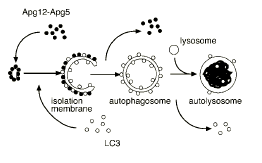Autophagy

The Mechanism of Autophagy
Autophagy is an intracellular degradation pathway in which cytoplasmic components are directed to the degradative organelle, the lysosome where the constituents are broken down. This membrane -mediated process proceeds in distinct steps. The cytoplasmic constituents are enclosed by the double membrane structure called the isolation membrane. The resultant autophagosome in turn fuses with the lysosome forming the autolysosome where the enclosed material is broken down.
Learn more about the mechanism of autophagy by reading one of the recent reviews: Ohsumi et al. 2001, Noda T., et al. 2002

The Importance of Autophagy
The importance of autophagy is demonstrated by the fact that all eukariotes investigated from yeast to mouse need autophagy to survive starvation (Kuma, A. et al. 2004). Disruption of autophagy appears to lead to cancer and accelerated ageing (Yue, Z. et al. 2003). Autophagy protects against formation of protein aggregates and hence protect against neurodegenerative disease in mice and Drosophila (Ravikumar B, Rubinsztein DC. 2004, Komatsu, M. et al. 2006, Hara, T. et al. 2006 ). Dysfunction of Autophagy is possibly involved in development of disease like Alzheimer and Huntington's disease. Autophagy has also been demonstrated to protect against invading bacteria, and is thus also a part of the immune system ( Nakagawa I. et al. 2004 ).
Learn more about the importance of autophagy by reading a recent review: Levine B, Klionsky DJ. 2004
